
To enlighten us on all things Awamori we have travelled to Ishigaki to visit Seifuku Shuzo and our host is Mr Shimizu Wakato. There are 47 Awamori distillers in the Okinawan prefecture of which 6 are located on Ishigaki. Seifuku Shuzo has been producing Awamori for 63 years and production is overseen by matriarch distiller/owner Keiko Kanna. Horibuchi San and I are in luck today as Kanna San, is overseeing the distillation of a small private batch with the help of a young worker. We are led upstairs into the inner sanctum, where a small still is fired with wood under Kanna San’s watchful eye.
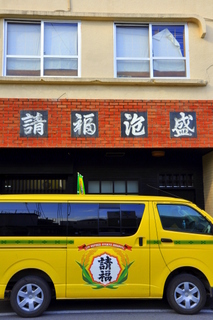

▲(right) The Koji
For this small batch around 120 litres of Moromi are distilled to produce 18 litres of Awamori and the distillation takes around 3 hours. But let’s turn the clock back. First the rice is washed then soaked for 15 hours, steamed for 3 hours and made ready for koji propagation that takes around two days. The resulting moromi of koji, water and yeast is added to the fermentation tanks with addition raw ingredient. During summer fermentation takes around 14 to 20 days, add up to another 10 during winter. Then it’s down to distillation followed by minimum 3 to 6 months storage in stainless tanks. Ageing is good for Awamori, as is the case for whisky and Scotch the aging rounds the edges and softens the palette. To be classed as Kusu (aged Awamori) it’s laid to rest for 3 years but 10 years is better and 20-25 years best, but this obviously adds cost to the product and a lot of patience from the distiller.
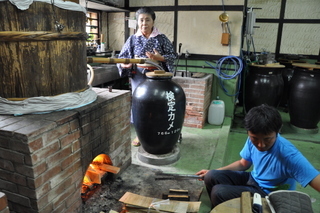
▲Small Batch Distilling
I do enjoy Awamori immensely; its rich earthiness and depth of flavour create a drink that is well matched with food and very enjoyable over ice as a digestive. Typically the locals enjoy it with either iced or warm water; a 50/50 ratio seems the way to go.
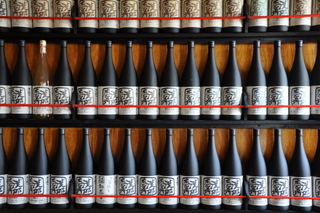
▲Seifuku Bottles
1996 heralded the start of a 10 year boom in appreciation of Shochu and Awamori, many Okinawan celebrities helped fuel this love affair for the southern spirit. In recent years the fascination has waned due to increased pressure of western beverages, such as wine and the whisky high ball craze. Seifuku Shuzo has risen to the challenge, offering an impressive selection of 40 different product lines, including various vintages of Kusu and a line of liquors. Their passionfruit umeshu, ginger liquor and coffee liquor all deserve a place in bars worldwide.
That evening Wakato San treats us to local Izakaya fare and like their local drop Awamori, the hospitality is warming and memorable.
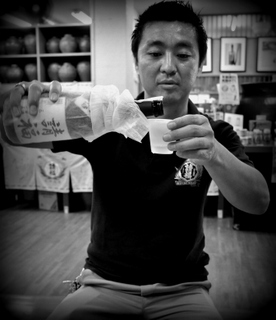
The next morning finds us once again at the local airport. It is sad day, my travel companion and exporter extraordinaire Mr Bungo Horibuchi must return to Kobe, and I and my liver must forge ahead. I have one last tipple to enjoy before this party is over, for me it’s onward to the main island of Okinawa where a crisp, cold pint of Orion beer awaits…
………………………………………………………………………………………………………………………………………………………………………
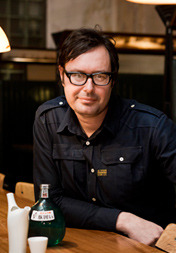 Andre Bishop is a Melbourne based Sake Professional and is recognized as one of Australia’s leading authorities on Sake. His 12 years of experience in designing Asian and specifically Japanese venues include well know Melbourne establishments Robot Bar and Golden Monkey. He currently owns the 22 year old Japanese dining institution Izakaya Chuji and Sake Bar Nihonshu. He is also co-owner and founder of Melbourne’s flagship Izakaya and Sake Bar, Kumo in Brunswick East. Andre studied Sake in Japan and is the only Australian who currently holds a Level 2 Sake Professional Certificate from the International Sake Education Council.
Andre Bishop is a Melbourne based Sake Professional and is recognized as one of Australia’s leading authorities on Sake. His 12 years of experience in designing Asian and specifically Japanese venues include well know Melbourne establishments Robot Bar and Golden Monkey. He currently owns the 22 year old Japanese dining institution Izakaya Chuji and Sake Bar Nihonshu. He is also co-owner and founder of Melbourne’s flagship Izakaya and Sake Bar, Kumo in Brunswick East. Andre studied Sake in Japan and is the only Australian who currently holds a Level 2 Sake Professional Certificate from the International Sake Education Council.
Andre is available for Consulting on Sake, Japanese Beverage Lists, Sake Staff Training and Sake Equipment. Contact: andrebishopsan@gmail.com
Sake Master Andre’s blog: www.sakemaster.com.au
Twitter: sakemasterandre
Sipping with the Sake Master #7
Sipping with the Sake Master #6.2
Sipping with the Sake Master #6.1
Sipping with the Sake Master #5.2
Sipping with the Sake Master #5.1
Sipping with the Sake Master #4
Sipping with the Sake Master #3
Sipping with the Sake Master #2
Sipping with the Sake Master #1
Please click here for Sake Master Andre Bishop’s older interview



